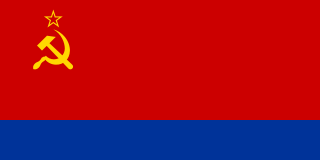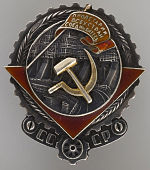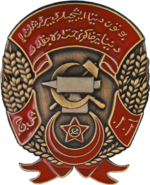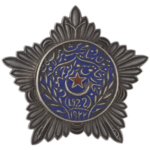
The Republics of the Union of Soviet Socialist Republics or the Union Republics were national-based administrative units of the Union of Soviet Socialist Republics (USSR). The Soviet Union was formed in 1922 by a treaty between the Soviet republics of Byelorussia, Russian SFSR (RSFSR), Transcaucasian Federation, and Ukraine, by which they became its constituent republics of the Union of Soviet Socialist Republics.

Valentin Sergeyevich Pavlov was a Soviet official who became a Russian banker following the dissolution of the Soviet Union. Born in the city of Moscow, then part of the Russian Soviet Federative Socialist Republic, Pavlov began his political career in the Ministry of Finance in 1959. Later, during the Brezhnev Era, he became head of the Financial Department of the State Planning Committee. Pavlov was appointed to the post of Chairman of the State Committee on Prices during the Gorbachev Era, and later became Minister of Finance in Nikolai Ryzhkov's second government. He went on to succeed Ryzhkov as head of government in the newly established post of Prime Minister of the Soviet Union.

The Transcaucasian Socialist Federative Soviet Republic, also known as the Transcaucasian Soviet Federative Socialist Republic, or simply Transcaucasia, was a republic of the Soviet Union that existed from 1922 to 1936.

The Azerbaijan Soviet Socialist Republic, also referred to as the Azerbaijani Soviet Socialist Republic, Azerbaijan SSR, Azerbaijani SSR, AzSSR, Soviet Azerbaijan or simply Azerbaijan, was one of the constituent republics of the Soviet Union between 1922 and 1991. Created on 28 April 1920 when the Russian Soviet Federative Socialist Republic brought pro-Soviet figures to power in the region, the first two years of the Azerbaijani SSR were as an independent country until incorporation into the Transcaucasian SFSR, along with the Armenian SSR and the Georgian SSR.
A People's Commissariat was a structure in the Soviet state from 1917–1946 which functioned as the central executive body in charge of managing a particular field of state activity or a separate sector of the national economy; analogue of the ministry. As a rule, a People's Commissariat was headed by a People's Commissar, which is part of the government – the Council of People's Commissars of the appropriate level.

The State Bank of the USSR, from 1921 to 1923 State Bank of the RSFSR and commonly referred to as Gosbank, was the central bank and main component of the single-tier banking system of the Soviet Union from 1922 to 1991. After an extended gap in 1920–1921, it took over the legacy of the State Bank of the Russian Empire. With the dissolution of the Soviet Union, it was terminated on 1 March 1992 and its local operations were taken over by the newly formed central banks of the post-Soviet states such as the National Bank of Kazakhstan, Central Bank of Russia (CBR), or National Bank of Ukraine, while the CBR inherited its central operations.
The title of Hero is presented by various governments in recognition of acts of self-sacrifice to the state, and great achievements in combat or labor. It is originally a Soviet-type honor, and is continued by several nations including Belarus, Russia, and Ukraine. It was also awarded to cities and fortresses for collective efforts in heroic feats. Each hero receives a medal for public display, special privileges and rights for life, and the admiration and respect of the nation. Some countries without Soviet connections also award Hero honours.

The Order of Friendship of Peoples was an order of the Soviet Union, and was awarded to persons, organizations, enterprises, military units, as well as administrative subdivisions of the USSR for accomplishments in strengthening of inter-ethnic and international friendship and cooperation, for economical, political, scientific, military, and cultural development of the Soviet Union.

The Academy of Sciences of the Soviet Union was the highest scientific institution of the Soviet Union from 1925 to 1991. It united the country's leading scientists and was subordinated directly to the Council of Ministers of the Soviet Union.

The Ministry of Finance of the Union of Soviet Socialist Republics (USSR) (Russian: Министерство финансов СССР), formed on 15 March 1946, was one of the most important government offices in the Soviet Union. Until 1946 it was known as the People's Commissariat for Finance (Russian: Народный комиссариат финансов – Narodnyi komissariat finansov, or "Narkomfin"). Narkomfin, at the all-Union level, was established on 6 July 1923 after the signing of the Treaty on the Creation of the USSR, and was based upon the People's Commissariat for Finance of the Russian Soviet Federative Socialist Republic (RSFSR) formed in 1917. The Ministry was led by the Minister of Finance, prior to 1946 a Commissar, who was nominated by the Chairman of the Council of Ministers and then confirmed by the Presidium of the Supreme Soviet. The minister was a member of the Council of Ministers.

The postage stamps and postal history of Azerbaijan describes the history of postage stamps and postal systems in Azerbaijan, which closely follows the political history of Azerbaijan, from its incorporation to the Russian Empire in 1806, to its briefly obtained independence in 1918, which it lost to the Soviet Union in 1920 and re-acquired in 1991 after the dissolution of the Soviet Union.

The Russian Soviet Federative Socialist Republic, previously known as the Russian Soviet Republic and the Russian Socialist Federative Soviet Republic, and unofficially as Soviet Russia, was an independent federal socialist state from 1917 to 1922, and afterwards the largest and most populous constituent republic of the Soviet Union (USSR) from 1922 to 1991, until becoming a sovereign part of the Soviet Union with priority of Russian laws over Union-level legislation in 1990 and 1991, the last two years of the existence of the USSR. The Russian SFSR was composed of sixteen smaller constituent units of autonomous republics, five autonomous oblasts, ten autonomous okrugs, six krais and forty oblasts. Russians formed the largest ethnic group. The capital of the Russian SFSR and the USSR as a whole was Moscow and the other major urban centers included Leningrad, Stalingrad, Novosibirsk, Sverdlovsk, Gorky and Kuybyshev. It was the first socialist state in history.

The Government of the Union of Soviet Socialist Republics (USSR) was the executive and administrative organ of the highest body of state authority, the All-Union Supreme Soviet. It was formed on 30 December 1922 and abolished on 26 December 1991. The government was headed by a chairman, most commonly referred to as the premier of the Soviet Union, and several deputy chairmen throughout its existence. The Communist Party of the Soviet Union (CPSU), as "The leading and guiding force of Soviet society and the nucleus of its political system" per Article 6 of the state constitution, controlled the government by holding a two-thirds majority in the All-Union Supreme Soviet. The government underwent several name changes throughout its history, and was known as the Council of People's Commissars from 1922 to 1946, the Council of Ministers from 1946 to 1991, the Cabinet of Ministers from January to August 1991 and the Committee on the Operational Management of the National Economy from August to December 1991.

The All-Union Congress of Soviets was formally the supreme governing body of the Soviet Union from its formation until the adoption of its second constitution in 1936. The Congress of Soviets determined the general direction of all public bodies and elected the Central Executive Committee of the Soviet Union: a body which was accountable to, and held the powers of the Congress when the Congress was not in session. Despite its nominal authority, in practice the Congress served as a rubber-stamp for the Communist Party. With the 1936 Constitution, the All-Union Congress was replaced by the Supreme Soviet.

The Council of People's Commissars of the Russian Soviet Federative Socialist Republic was the government of Soviet Russia between 1917 and 1946. It was established by the Second All-Russian Congress of Soviets of Workers', Soldiers', and Peasants' Deputies on November 9, 1917 "as an interim workers' and peasants' government" under the name of the Council of People's Commissars, which was used before the adoption of the Constitution of the Russian Socialist Federative Soviet Republic of 1918.

The All-Russian Congress of Soviets evolved from 1917 to become the supreme governing body of the Russian Soviet Federative Socialist Republic from 1918 until 1936, effectively. The 1918 Constitution of the Russian SFSR mandated that Congress shall convene at least twice a year, with the duties of defining the principles of the Soviet Constitution and ratifying peace treaties. The October Revolution ousted the provisional government of 1917, making the Congress of Soviets the sole, and supreme governing body. This Congress was not the same as the Congress of Soviets of the Soviet Union which governed the whole Soviet Union after its creation in 1922.

The State Emblem of the Soviet Union was the official symbol of the Union of Soviet Socialist Republics adopted in 1923 and used until the dissolution of the state in 1991. Although it technically is an emblem rather than a coat of arms, since it does not follow traditional heraldic rules, in Russian it is called герб, the word used for a traditional coat of arms.

The Emblem of the Russian Soviet Federative Socialist Republic was adopted on 10 July 1918 by the Government of the Soviet Union, and had been modified several times afterwards. It shows wheat as the symbol of agriculture, a rising sun to symbolize the republic's future, the red star as well as the hammer and sickle for the victory of communism and the "world-wide socialist community of states".

The Council of People's Commissars (CPC) (Russian: Совет народных комиссаров (СНК), romanized: Sovet narodnykh kommissarov (SNK)), commonly known as the Sovnarkom (Совнарком), were the highest executive authorities of the Russian Soviet Federative Socialist Republic (RSFSR), the Soviet Union (USSR), and the Soviet republics from 1917 to 1946.
The People's Commissariat of Justice of the Russian Soviet Federative Socialist Republic was an executive body within the Soviet government of Russia in charge of the organization and functioning of the justice system.










































